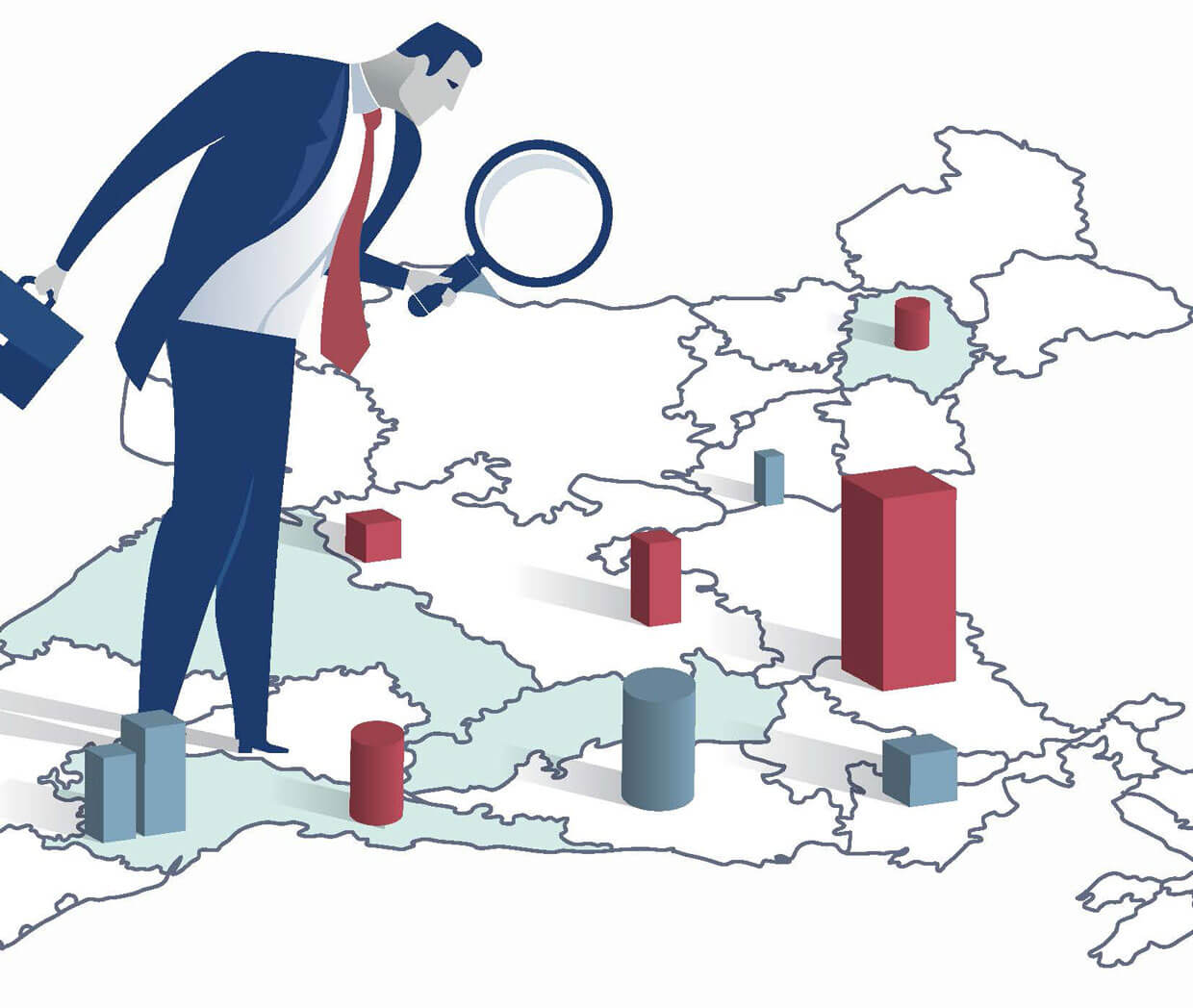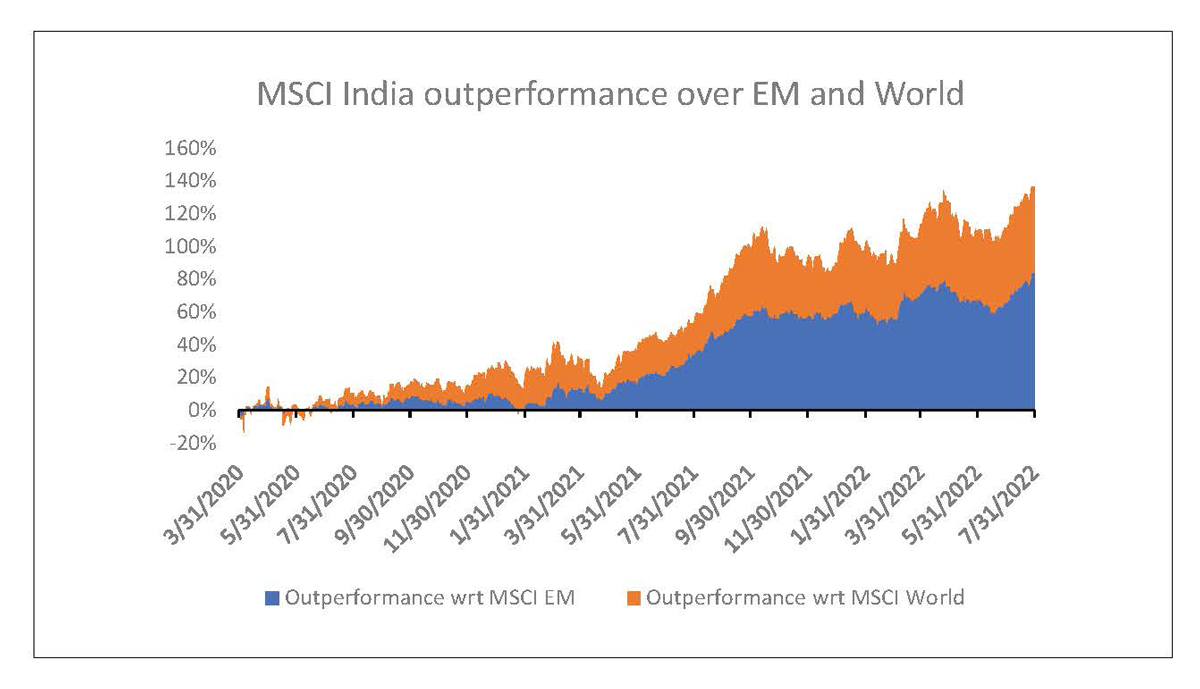
Macro and
Equity Market
Outlook
Equity Market
Outlook
Global Macro & Markets
Last month turned to be a strong for the Indian and global markets. Major global market majorly rose over the month, with the exceptions of the Hang Seng index (-7.8%) falling, as well as the MSCI EM declining incrementally (-0.7%). MSCI World rose 7.9%,
in line with the rise in S&P500 (9.1%) and Euro-50 (7.3%). Additionally, NIFTY 50 India, BOVESPA Brazil and MOEX Russia rose 8.7%, 4.7% and 0.4% respectively. LME Metals Index witnessed a slight fall of -0.7% MoM owing
to fears of weakening demand and a gloomier economic outlook. Brent crude was down 6.8%m/m in July’22. Dollar index gained 1.2% over the month. US, Germany, and India 10Y G-Sec rates were down by 36, 52 and 13 bps MoM respectively
and settled at 2.65%, 0.82% and 7.32% respectively.
Domestic Macro & Markets
SENSEX rose 8.6% in July’22. Mid-cap outperformed large-cap and was up 12%m/m. On the sectoral front, all sectors delivered positive, with metals, realty and capital goods rising 17%, 17% and 14% respectively. Market breadth improved over the month with
53% of BSE 100 stocks trading above their respective 200-day moving averages, up from the 16% at the end of Jun’22. Net institutional flow rose to US$1.9bn with FPI inflows ending positive for the first time since September
2021, and domestic mutual funds recording inflows for the 17th straight month. FPIs sold US$28 Mn (as on Jul 28, 2022) worth of Indian equities in the secondary market while DIIs bought US$1.3 bn (as on Jul 29, 2022).

India's high frequency data update:
Rising GST collections, strength core, manufacturing & agricultural sectors, rising exports and accelerating credit growth bode well for the economy.
Manufacturing PMI:
Manufacturing PMI, rose to an 8-month high at 56.4 in July’22, after recording a 53.9 in Jun’22, on the back of new orders, with manufacturers seeing noticeable growth in new business and output.
GST Collection:
INR 1.49 Tn (+28% YoY) in July’22 recorded the fifth consecutive month of collections over 1.4Tn mark, at the second highest figure collected, implying healthy economic activity and improvement in tax compliance. The growth could also be attributed to
low base (second COVID wave) and transmission of elevated commodity prices.
Core sector production:
Core sector production rose 12.7% YoY in Jun’22, moderating against a YoY rise of 18.1% in May’22. Growth was mainly led by electricity output, which was up by 15.5% and steel output up by 3.3% YoY.
Industrial Production:
Manufacturing IIP increased 19.64% in May’22 vs 27.61% rise in May last year, on account of a boost in manufacturing and electricity, making it the 15th straight month of positive IIP growth for the Indian economy.
Credit growth:
Credit growth accelerated to 14.04% YoY as of 15-July’22 against YoY growth of 6.45% as observed on 16-July 2021. Aggregate deposits also grew 8.35% YoY.
Inflation:
CPI inflation in Jun’22 moderated marginally to 7.01% from 7.04% in May’22 led by moderation in sequential momentum. WPI inflation in Jun’22 fell 70bps to 15.2%.
Trade Deficit:
The trade deficit in Jun’22 widened to a record US$25.63 Bn as compared to US$23.1 Bn in May’22. Merchandise exports increased 16.8% YoY to US$37.9 Bn while imports increased by 51% YoY to $63.6 Bn.
Indian Monsoon:
Till July 29th,2022, Indian monsoon rainfall across the country was 9% above the long-term average on a cumulative basis. On a cumulative basis, rainfall distribution of monsoon showed surplus rainfall (excess over long term trend), across central, northwest,
and southern India while it remained weaker in the east and northeast. Out of the 36 sub-divisions across India, seven have received deficient rainfall, 15 have received normal rainfall, and 14 have received excess rainfall.
Reservoir storage levels remained well in surplus of long-term cumulative amounts, and overall, basins and reservoirs were around 39.5% above long-term average for week ending July 28, 2022.
Market View
During the month of July’22, the investor sentiment improved on account of better corporate earnings announcements, hinting of a slower rate hike trajectory by US Fed as it weighed concerns on potential recession over high inflation and lower FPI outflows
in secondary market of Indian equities. We believe inflation may be closer to peaking out globally given the cool off in most of the commodity prices including oil prices.
Domestic high frequency indicators remained resilient despite the cyclical headwinds underlining the domestic recovery possibilities. Policy reforms, huge under investments in Capex, stronger corporate Balance Sheets alongside a transition to a multipolar
world can aid manufacturing, exports and capex - creating a virtuous cycle of growth.
Accordingly, we are attempting to maintain balanced portfolios through a combination of domestic recovery themes along with secular businesses. The attempt is to identify relatively better valued opportunities across these themes.
From an investor’s perspective given the external risks and its potential impact investing in a staggered manner or systematic route may help iron out market extremes. Based on the prevailing valuations diversified funds with allocations across market
cap range may be considered from a medium-term view. Conservative investors seeking equity exposure with lower volatility may consider asset allocation strategies like - Balanced Advantage/Asset Allocator which manage equity
allocations dynamically.
Note:The sectors mentioned are not a recommendation to buy/sell in the said sectors. The schemes may or may not have future position in the said sectors. For complete details on Holdings & Sectors of NIMF
schemes, please visit website mf.nipponindiaim.com.;
Past performance may or may not be sustained in future
Past performance may or may not be sustained in future
Chart of the month :
Indian equity markets continued to outperform most other global markets post-COVID.

Common Source:
Bloomberg, Nippon India Mutual Fund Research
Disclaimer:The information herein above is meant only for general reading purposes and the views being expressed only constitute opinions and therefore cannot be considered as guidelines, recommendations
or as a professional guide for the readers. The document has been prepared on the basis of publicly available information, internally developed data and other sources believed to be reliable. The sponsors, the Investment
Manager, the Trustee or any of their directors, employees, Associates or representatives (‘entities & their Associate”) do not assume any responsibility for, or warrant the accuracy, completeness, adequacy and reliability
of such information. Recipients of this information are advised to rely on their own analysis, interpretations & investigations. Readers are also advised to seek independent professional advice in order to arrive at an
informed investment decision. Entities & their associates including persons involved in the preparation or issuance of this material, shall not be liable in any way for any direct, indirect, special, incidental, consequential,
punitive or exemplary damages, including on account of lost profits arising from the information contained in this material. Recipient alone shall be fully responsible for any decision taken on the basis of this document.
